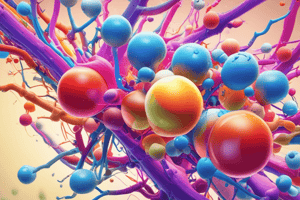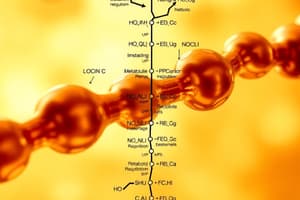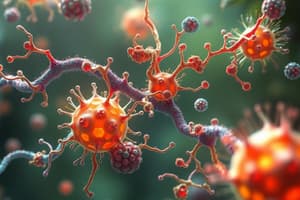Podcast
Questions and Answers
What is the relationship between anabolic and catabolic reactions in the concept of metabolism?
What is the relationship between anabolic and catabolic reactions in the concept of metabolism?
Metabolism is the sum of all anabolic and catabolic reactions in a cell, connected in a network of reaction pathways.
What are the defining characteristics of anabolic reactions?
What are the defining characteristics of anabolic reactions?
Anabolic reactions synthesize or 'build' molecules with more bonds, making higher free energy products; they also use or store energy (endergonic), reduce entropy, and are non-spontaneous.
How do catabolic reactions differ from anabolic reactions?
How do catabolic reactions differ from anabolic reactions?
Catabolic reactions degrade or 'break' molecules to make lower free energy products with fewer bonds; they also increase entropy and release energy (exergonic), and are spontaneous.
What is the relationship between the First and Second Laws of Thermodynamics and the concept of free energy?
What is the relationship between the First and Second Laws of Thermodynamics and the concept of free energy?
How does the change in free energy, $\Delta G$, determine the direction of a reaction?
How does the change in free energy, $\Delta G$, determine the direction of a reaction?
What is the primary role of enzymes in chemical reactions?
What is the primary role of enzymes in chemical reactions?
How does the structure of an enzyme relate to its specificity and function?
How does the structure of an enzyme relate to its specificity and function?
Describe the interaction between an enzyme and its substrate at the active site.
Describe the interaction between an enzyme and its substrate at the active site.
How do anabolic reactions differ from catabolic reactions in terms of energy changes?
How do anabolic reactions differ from catabolic reactions in terms of energy changes?
What is the relationship between entropy and the spontaneity of a reaction?
What is the relationship between entropy and the spontaneity of a reaction?
What is the role of allosteric effectors in enzyme regulation?
What is the role of allosteric effectors in enzyme regulation?
How can metabolic pathways be regulated at different steps?
How can metabolic pathways be regulated at different steps?
What is the purpose of negative feedback (or feedback inhibition) loops in metabolic pathways?
What is the purpose of negative feedback (or feedback inhibition) loops in metabolic pathways?
Explain the concept of reaction coupling and how it is used to accomplish positive $\Delta$G reactions in cells.
Explain the concept of reaction coupling and how it is used to accomplish positive $\Delta$G reactions in cells.
Describe the role of ATP in coupled reactions and the continuous cycling of ATP in cells.
Describe the role of ATP in coupled reactions and the continuous cycling of ATP in cells.
Explain the concept of redox reactions and the role of electron carriers like NADH and NADPH in metabolism.
Explain the concept of redox reactions and the role of electron carriers like NADH and NADPH in metabolism.
State the first and second laws of thermodynamics and explain how they relate to energy transformations in cellular processes.
State the first and second laws of thermodynamics and explain how they relate to energy transformations in cellular processes.
Describe the relationship between enthalpy, entropy, and free energy in chemical reactions, and how this relates to the spontaneity of reactions.
Describe the relationship between enthalpy, entropy, and free energy in chemical reactions, and how this relates to the spontaneity of reactions.
Distinguish between anabolic and catabolic reactions in terms of change in free energy, change in entropy, spontaneity, and whether they are endergonic or exergonic.
Distinguish between anabolic and catabolic reactions in terms of change in free energy, change in entropy, spontaneity, and whether they are endergonic or exergonic.
Explain the function of enzymes in relation to their structure and their role in negative $\Delta$G reactions, and discuss how enzymes are regulated in cells.
Explain the function of enzymes in relation to their structure and their role in negative $\Delta$G reactions, and discuss how enzymes are regulated in cells.
Flashcards
Allosteric Effector
Allosteric Effector
Molecules bind to this site, changing the enzyme's shape to either inhibit or activate its function.
Reaction Coupling
Reaction Coupling
Combining a reaction with a positive change in Gibbs free energy (G) with one that has a negative change in G, resulting in an overall negative change in G.
Oxidation
Oxidation
The loss of electrons from a molecule.
Reduction
Reduction
Signup and view all the flashcards
NADH (or NADPH)
NADH (or NADPH)
Signup and view all the flashcards
First and Second Laws of Thermodynamics
First and Second Laws of Thermodynamics
Signup and view all the flashcards
Free Energy (G)
Free Energy (G)
Signup and view all the flashcards
Anabolic Reactions
Anabolic Reactions
Signup and view all the flashcards
Catabolic Reactions
Catabolic Reactions
Signup and view all the flashcards
Enzymes
Enzymes
Signup and view all the flashcards
Active Site
Active Site
Signup and view all the flashcards
Enzyme-Substrate Complex
Enzyme-Substrate Complex
Signup and view all the flashcards
Study Notes
Enzyme Regulation
- Allosteric effectors bind to the allosteric site, altering the protein shape to inhibit or activate enzyme function.
- Metabolic pathways are regulated at different steps depending on the cell's demands.
Reaction Coupling
- Positive ∆G reactions are accomplished by combining a positive ∆G reaction with a negative ∆G reaction to achieve a net negative ∆G.
- The most common means of reaction coupling is to use the hydrolysis of ATP, yielding a ∆G = -7.3 kcal/mole, to generate phosphorylated intermediate molecules of higher energy.
- ATP is continuously used and regenerated from ADP + Pi.
Redox Reactions
- Oxidation is the loss of electrons, while reduction is the gain of electrons by molecules.
- NADH (or NADPH) is a high-energy electron carrier that captures high-energy electrons from organic molecules and holds on to them for later use.
Thermodynamics
- The First and Second Laws of Thermodynamics state that energy is transformed, but always at the cost of energy lost through entropy.
- Free energy (G) is the chemical energy available to do work, expressed as the difference between enthalpy (total energy) and entropy.
- Any reaction involves a change in free energy, ∆G, between reactants and products.
Anabolic and Catabolic Reactions
- Anabolic reactions synthesize or "build" molecules with more bonds, increasing free energy, reducing entropy, and are non-spontaneous (endergonic).
- Catabolic reactions degrade or "break" molecules to make lower free energy products with fewer bonds, increasing entropy, releasing energy, and are spontaneous (exergonic).
Enzymes
- Enzymes are proteins that reduce the activation energy of a reaction.
- Enzyme specificity and function result from the structure (shape) of the protein.
- Substrates interact with enzymes at the active site, forming an enzyme-substrate complex with a close interaction through induced fit.
- Enzymes can be regulated by allosteric effectors, negative feedback loops, and reaction coupling.
Studying That Suits You
Use AI to generate personalized quizzes and flashcards to suit your learning preferences.




